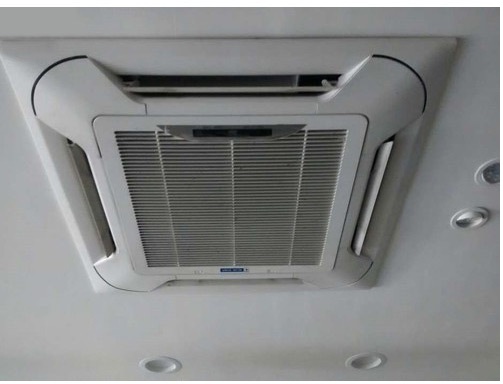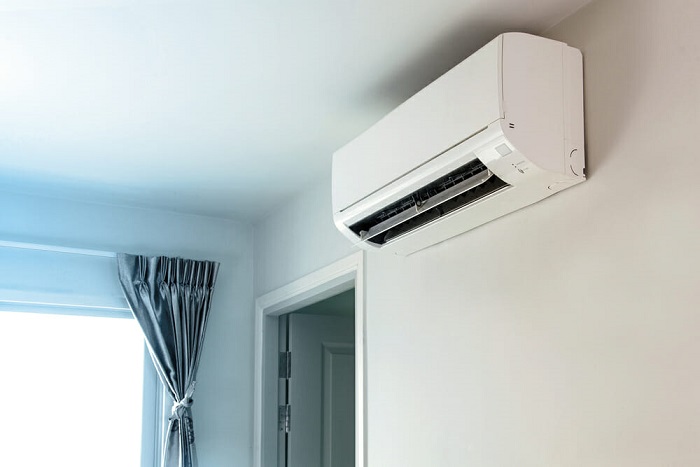Are you planning to get a new air conditioning system installed in your home?
Confused among the different options available? Deciding which one is right can be quite overwhelming.
To make it easier for you, we have come up with this new blog. Here, we bring to you the two most popular options – Central AC and Split AC.
Let us help you make the right decision. In this article, we will discuss their features, how these systems work, their energy usage, and the pros and cons of each.
What is Central AC?
A central AC, as the name suggests, is a centralized air conditioning unit specially designed for office spaces, malls, large rooms, etc. It works by cooling air at one central location and then distributes the same to your whole house or multiple rooms through fans and a series of ducts. Hence, it is also called the duct system.
Also known as the duct system, a central AC has supply-ducts and return-ducts. While the supply ducts circulate the cool air into your home, the reverse ducts collect the warm air across your home.
In a central AC, there is a single and centralized cooling unit. Hence, and you cannot change the temperature for individual rooms. One unique feature of a central AC is that it is invisible.
What is Split AC?
A split AC is that type of air conditioner, having a huge demand for its greater efficiency and improved performance. This arrangement usually consists of two components, namely, the indoor and the outdoor components. The indoor unit comprises the evaporator, whereas the outdoor unit has a compressor and condenser.
The internal component, which mounts to the ceiling or wall indoors, remains connected to the condenser (located outside) through a conduit. A refrigerant or the cooling circulates through this conduit and then into the room, keeping the room cool.
A split AC is available in both single split and multi-split indoor units, wherein a single split AC has one indoor unit and one outdoor connected by a copper wire. The multi-split AC system has more than one indoor unit and a single outdoor unit, capable of cooling and heating several rooms in the home through just one outdoor unit.
A single split AC is ideal for an individual room, and a multi-split is suitable for several rooms. The upside to these air conditioning units is that they allow independent operation control for all the rooms.
To make the understanding easier, we listed below the key distinguishing features of the duo.
Click Here To Portable Ac Vs Split Ac and Window AC vs Split AC
Central AC vs. Split AC
|
PARAMETERS |
CENTRAL AC |
SPLIT AC |
|
Components |
It is a centralized unit with network of ducts |
It has two components – an Indoor & Outdoor unit |
|
Air Circulation |
Supply ducts circulate air for all rooms |
Indoor unit blows air |
|
Energy Efficiency |
It is dependent on the Ducts |
High energy-efficiency |
|
Temperature Control |
By one centrally-located thermostat |
By specific zones or rooms |
|
Installation |
Not easy to install – Requires Ductwork |
Easy to install |
|
Maintenance |
Difficult to maintain & Expensive |
Not expensive when compared to central AC |
|
Appearance |
Virtually Invisible |
Visible |
|
Initial cost |
High |
Low |
|
Suitable for |
Cooling Entire House |
Cooling Single or multiple rooms |
Let us get into the details of all the parameters, as mentioned above:
1. Initial Cost and Maintenance Cost
Cost is the key indicating factor for making any purchase. When it comes to these devices, the initial cost of a split AC is low in comparison to a central AC. The upfront cost of a central unit is also low, provided you have the ductwork already installed.
A split AC is versatile, easy-to-maintain, and also requires low repair and maintenance costs. Contrary to this, a central unit has high maintenance, which can prove costly in the long-run if not regularly maintained.
2. Ease of Installation
The installation of a central AC and a split AC are two different things that are highly distinctive. For installing a central AC, you need to get the ductwork done, which is really expensive and tedious, too.
Unlike central AC units, the split ACs are easier to install and require only a small hole through the wall. A small refrigerant that connects the wall-mounted indoor unit and the outdoor compressor passes through this hole.
It usually takes about a week for the technical experts to install the central AC. If you do not have the ductwork done already, it may take a little longer. Split AC installation takes just one day for the process.
3. Energy Efficiency
Central AC units are comparatively less efficient than the split ACs. As discussed earlier, the cool air passes through the ducts to circulate the air in the room. In case of cracks or holes in the ductwork, it will allow the cool air to escape. This makes your AC unit work harder, consuming more energy, thereby contributing to high electricity bills.
On the other hand, a split AC has no ductwork, eliminating the scope for the air to escape. It is highly energy-efficient and has a high cooling capacity. It circulates clean and fresh air by purifying the air that enters the room.
4. Indoor Air Quality
Since ducts are the only source to circulate the air inside the room for central ACs, there are chances that dust, pollutants, and other allergens get trapped in these ducts. Irregular maintenance of these ducts can impact the air quality and cooling efficiency of the system.
It is crucial to get the ducts cleaned frequently to ensure clean air and the proper health of your family members. You can also add air purification units to your central AC to improve the quality of air.
Poor air quality from central ACs can make your family members prone to skin irritation and other respiratory problems. It can worsen the condition of those who already have asthma. Children, elderly people, and others with ill health or existing respiratory problems are susceptible.
The best thing about split AC is that they have air filters that obstruct the entry of pollutants, allergens, and dirt inside. The built-in filters and air purification systems come equipped in these units to ensure fresh, cool, and filtered air that is dust and pollutants-free. This way, it helps you lower the medical bills of your family.
5. Temperature Controls
Central air conditioners have a centrally-located thermostat that allows for collective temperature control in all the rooms. The temperature cannot vary for individual rooms. That means there is only one temperature for the entire house. Split air conditioners offer individualized temperature controls for several zones. In simple words, you can set different temperatures for different zones based on your personal comfort level.
6. Design Elements
If you are particular about the design and look, then central air conditioners are the least visible equipment that will not change the aesthetic appeal of your home. And, what’s more? You can easily camouflage the outdoor compressor with landscaping, to make the indoor vent unnoticeable. You will not need any new air vents if you already have enough.
Split air conditioners being wall-mounted devices, are very much visible to the naked eye. They may disturb the aesthetic look of your décor. However, many new models are available that will enhance the indoor appeal of their work of art.
7. Long-Term Efficiency
The longevity of the central A/C units is for about 12 to 15 years, whereas split ACs can operate for up to 20 years. The mini-split version is also highly energy-efficient and cost-effective in the long run.
Frequently Asked Questions
Instead of a single unit, a split AC has two separate units. An outdoor condensing unit and an indoor air-handling unit. Hence, the name split AC. You can install separate air handling units for different rooms. Then, you can connect them to the same condensing unit.
Technically, a split system can cool up to 4 rooms. Each room will have a separate air handling unit. Hence, you can vary the temperature of each room.
It is very easy to install split systems since they do not use duct tapes. The cost of installation varies widely. It mainly depends upon the number of air handling units you want to install. However, the installation cost is low compared to that of other ACs
Yes, you can save power by putting your AC ic auto mode. It is energy-efficient. When your AC is in normal mode, the fan runs continuously even when the cycle is off. It consumes a lot of power. When you set it to auto mode, the compressor and fan run only when cooling is needed.
A central AC has a single centralized unit to condition air. It is present on the exterior of the building. It distributes the conditioned air to different rooms through a network of ducts.
The central ACs can be very expensive if you want to have a cooling effect for only one room. It has only one condensing unit and uses ducts to circulate air to different rooms. When you want to cool the entire home, it is one of the most affordable options.
The average life of a central air conditioner is 15 to 20 years. However, you need to maintain it properly. You have to clean the air ducts every 3-5 years. If you do not maintain it properly, its life span will become shorter.
Conclusion
To summarize, choosing the right cooling system depends on several factors other than their individual merits. Both central and split ACs are effective cooling systems. However, you should consider these parameters like it should match your home size and if it can help you enjoy the level of comfort control that you are looking for.
I hope this article helped you make a smart decision in choosing an air conditioning system that is right for your home.
If you still have questions or need more help, do not hesitate to write to us in the comments section below. We will help you in the decision-making process of which one is best for you.



